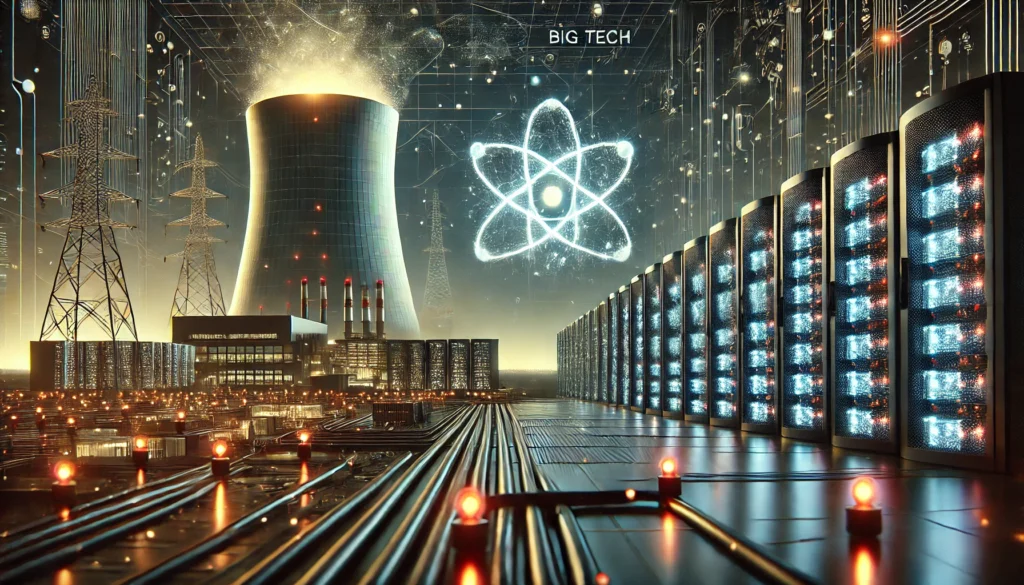We’re making this analogy that AI is the new electricity. Electricity transformed industries: agriculture, transportation, communication, manufacturing.– Andrew Ng
Dear Reader,
Big Tech just went nuclear. In one week, Amazon struck deals with utilities in Washington and Virginia to support the development of four small modular reactors (SMRs). They also invested in X-energy, a company at the forefront of SMR technology. Google made its own move, agreeing to buy power from SMRs built by Kairos Power. And Microsoft? It signed a 20-year deal that involves reopening a nuclear unit at Three Mile Island—the infamous plant in Pennsylvania, but not the one that partially melted down in 1979.
- Big Tech is investing in small modular reactors (SMRs) to meet the soaring power demands driven by AI and data centers.
- SMRs promise lower costs and quicker builds than traditional nuclear, but face challenges with regulatory approval and unproven performance.
- As tech companies dive into nuclear, there are concerns about overshadowing investments in wind and solar, and the need for regulatory oversight.
The rush isn’t just about cutting-edge nuclear tech; it’s about AI. Running artificial intelligence eats up power—lots of it. An AI query can take 10 times more energy than a regular Google search. Goldman Sachs projects that data centers’ power demand will jump 160% by 2030. The U.S. will need more juice for AI, electric cars, and the manufacturing comeback fueled by reshoring. That means electricity demand could double in the next decade.
Across the Atlantic, it’s a similar story. Europe’s power demand is set to surge by 40% from 2023 to 2033. The International Energy Agency even declared that the “age of electricity” is upon us, following the eras of coal and oil.
Tech’s Power Play
The tech giants are no strangers to wind and solar. They’ve poured billions into green energy. But the reality is they need more. Especially if they want to keep their promises of net-zero emissions while powering up their data centers. Nuclear energy—specifically SMRs—seems like a good bet. In theory, at least.
Nuclear is low-carbon. It cranks out reliable power, day and night, for decades. And it doesn’t go quiet when the wind stops or the sun sets. The big problem? Traditional nuclear plants are expensive and take ages to build. That’s where SMRs come in.
SMRs are smaller, up to 300 megawatts compared to the 1,000 megawatts of a standard reactor. They’re modular, largely prefabricated, and in theory, much cheaper and quicker to install. They can even be placed on sites like old coal plants, already hooked up to the grid.
High Hopes, Higher Risks
But that’s just the sales pitch. In reality, SMRs face a mountain of challenges. They might not be as cheap or fast as advertised. Regulatory approvals in the nuclear sector can be a nightmare. Safety standards are uncompromising, and for good reason. Critics argue that chasing SMRs might pull money away from proven green solutions like solar, wind, and batteries.
The numbers aren’t on their side. The Institute for Energy Economics and Financial Analysis looked at the handful of SMR-style projects worldwide and concluded they’re “too expensive, too slow, and too risky.” That hasn’t stopped Big Tech from diving in. With their deep pockets and knack for innovation, they could speed up SMR development, just as Elon Musk transformed space travel. But sticking with what works—reviving old plants like Three Mile Island and another site in Michigan—might be more realistic.
The New Energy Reality
No matter what, tech giants will have to keep investing in wind and solar. The explosion in AI-driven data needs will see to that. And with limited resources, regulators must make sure tech’s big money doesn’t crowd out other energy priorities. One idea? Require clean energy projects for data centers to be big enough to supply the grid, not just a few tech campuses.
AI can also be part of the solution. It shouldn’t just be an energy hog. It could help boost energy efficiency across grids, factories, and offices.
As the age of electricity takes hold, one thing is clear: Big Tech’s nuclear leap is a bet on the future. Whether it pays off is the real question.
The Morning Muster



